[ad_1]
Fall is actually one among my favorite situations to be throughout the yard. The cooler days and crisper air are a welcome discount after scorching, humid summers and make duties actually really feel a lot much less urgent. Plus, fall greens like cauliflower, broccoli, and rutabagas present ample, chill-sweetened harvests.
Nonetheless, fall gardens are infrequently wonderful. Though the cooler temperatures and shorter days lead to a decrease in pest pressure, a handful of pests nonetheless stick spherical. In case you occur to sort out an extreme quantity of of a laissez-faire technique, cabbage worms and aphids may shortly devour your in another case wonderful crops. Perception me, I’ve been there.
Understanding some frequent fall vegetable pests will make it simpler to distinguish the good guys from the unhealthy bugs. I’ll share some noteworthy pests and make clear helpful administration methods.
Aphids
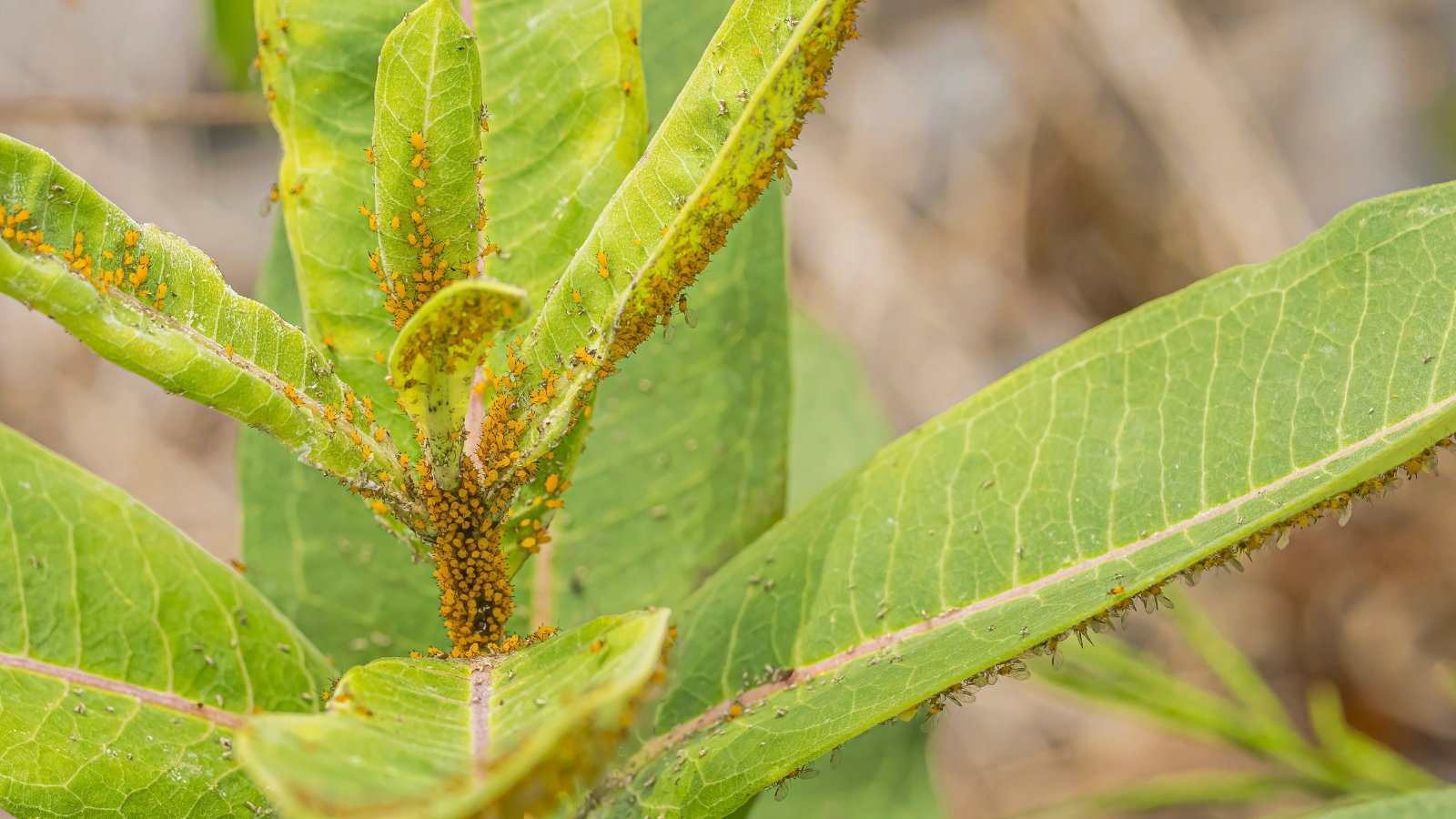

In case you occur to’ve grown crops for varied months, you’re perhaps acquainted with aphids. These small, soft-bodied pests assault a wide range of crops, from tropical houseplants to tall timber to hardy greens. There are numerous completely totally different aphid species, nevertheless all of them have comparable appearances and feeding methods.
Aphids have small straw-like mouthparts they use to pierce plant leaves after which drink the sap. Although only a few aphids gained’t set off any noticeable hurt, these vegetable pests can shortly multiply in any season, along with fall. An aphid can go from a brand new little one nymph to an grownup in beneath per week, and each female aphid can produce over 50 nymphs per week. Which suggests ten aphids can develop to over 1,000,000 in about six weeks!
Whereas aphids reproduce and mature slower throughout the fall than they do within the summertime, small populations can nonetheless develop shortly. And these larger populations can severely weaken all types of vegetable crops. On account of this truth, it’s best to get aphids beneath administration as rapidly as you see them.
Administration Selections
Although aphids are prevalent throughout the yard, many pure predators feed on them. Sustaining a varied habitat and avoiding broad-spectrum pesticides will encourage the presence of useful bugs like ladybugs, inexperienced lacewings, and parasitic wasps. These predators can seek out aphids and eat them sooner than they’ve time to balloon into a large downside.
Even while you try and protect a healthful ecosystem, aphids ought to develop to be a problem worth treating. In case you occur to find a dozen or so of the pests in your crops, it’s possible you’ll wipe them off with a moist, soapy rag. You can also attempt to clear them off your crops with a extremely efficient spray of the hose.
Larger outbreaks sometimes require further intensive methods. Spraying the soft-bodied pests with neem oil, insecticidal cleansing cleaning soap, or one different kind of horticultural oil will kill them. Be sure the spray contacts the pests for the simplest outcomes. Spray exterior peak pollinator train throughout the early morning or at dusk. A lightweight-weight mist is enough.
Harlequin Bugs
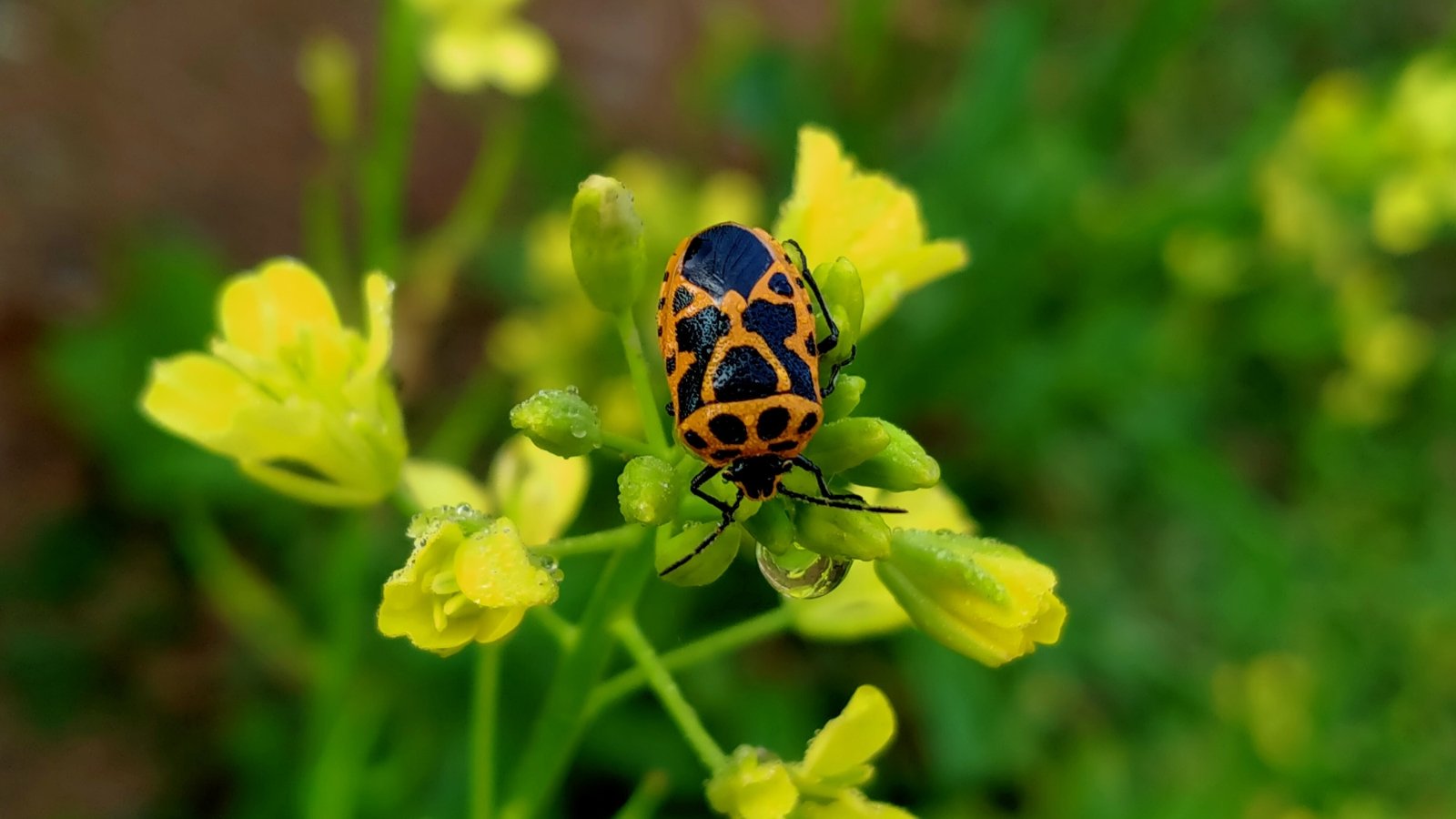

Harlequin bugs may look pretty, nevertheless don’t let their intricate pink, black, and white patterns fool you. These pests can set off essential hurt!
Via the autumn, you’re virtually actually to determine the grownup kind of the pest in your greens. They’re about half an inch prolonged with shield-shaped our our bodies very similar to stink bugs. In hotter areas, likelihood is you will proceed to see the black and white striped eggs and small black and pink nymphs all by the autumn.
These true bugs assault members of the Brassicae family, much like kale, cabbage, cauliflower, and broccoli. They use their piercing/sucking mouthparts to drink up plant sap, and their feeding ends in yellow or brown spots on leaves. When harlequin bugs appear in huge numbers, they are going to severely weaken and even kill crops. On account of this truth, it’s most interesting to get them beneath administration as rapidly as you see them appear.
Administration Selections
In case you occur to identify a handful of adults hanging spherical your cabbage crops or munching in your turnip greens, use your fingers to squash them. This usually is a messy job, nevertheless sporting gloves makes it further manageable. You can also determine the bugs off and place them in a container full of soapy water. The an identical goes for any egg tons likelihood is you will uncover.
You presumably can cope with larger infestations with pure pesticides like neem oil and insecticidal cleansing cleaning soap. Given that bugs generally lay their eggs on the undersides of leaves, make sure that to spray all sides of the foliage. You would possibly should make repeated features to completely eradicate them.
Armyworms
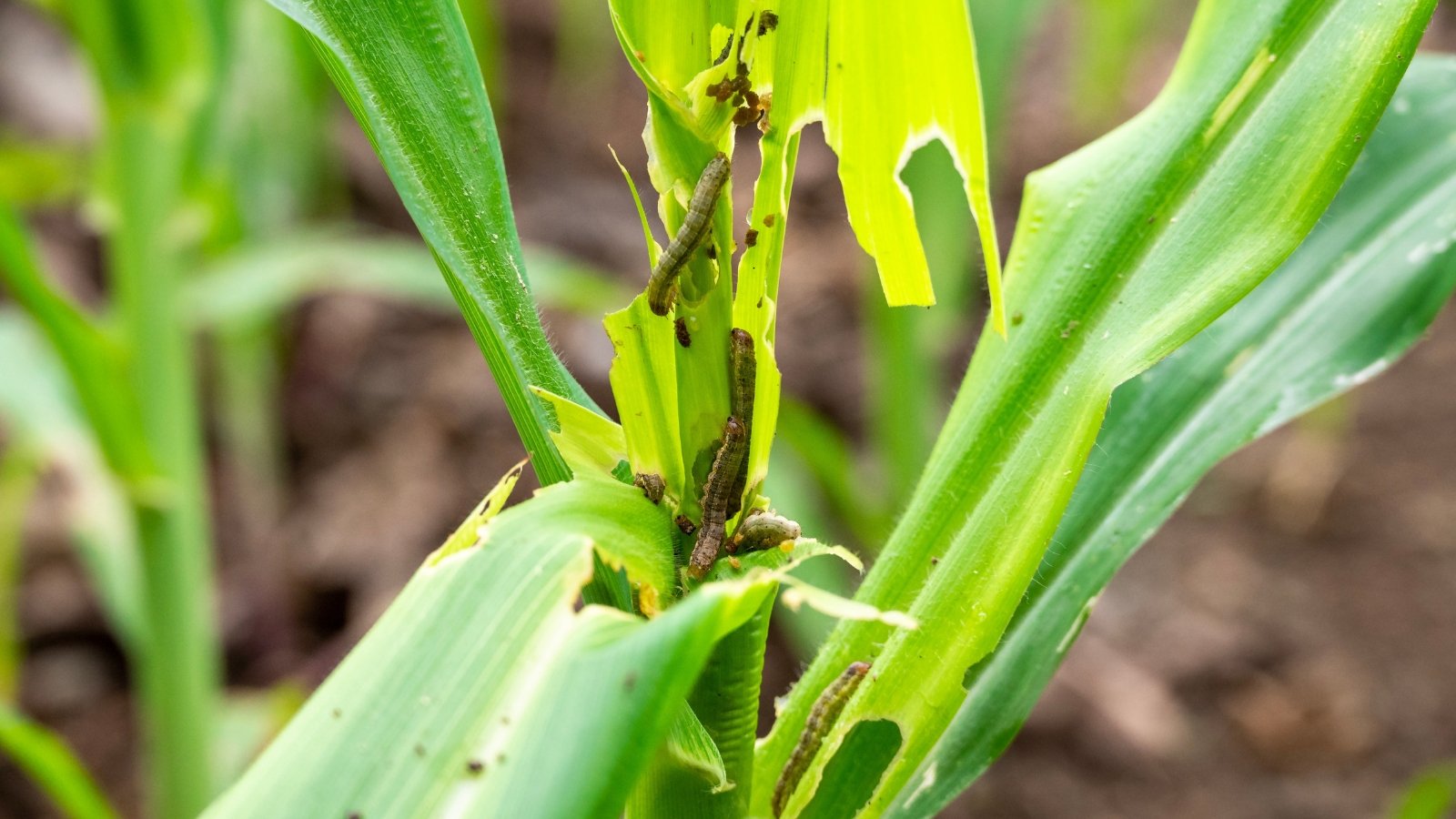

Quite a lot of species of armyworms can develop to be pests throughout the fall veggie yard. These embrace the autumn armyworm, beet armyworm, and southern armyworm. All kinds of armyworms are juvenile sorts of moths.
The juveniles are caterpillars that fluctuate in look counting on the species, age of larvae, and explicit individual. The larvae emerge decrease than 1 / 4 of an inch prolonged and develop to barely over an inch. They could be inexperienced, gray, black, brown, or some combination of these colors.
Armyworms get their determine from their tendency to journey in groups when looking for new meals sources. On account of this truth, huge numbers of pests can appear directly.
The affected crops vary counting on the armyworm species. Some veggies impacted embrace beets, broccoli, lettuce, and cabbage. Although it’s possible you’ll sometimes spot the pests themselves, you might also uncover irregularly fashioned holes throughout the leaves.
Administration Selections
One approach to cope with armyworms is to bodily take away them from the crops. Nonetheless, that’s sometimes powerful if the caterpillars are very small or present in huge numbers.
One different administration alternative accommodates spraying the affected crops with a naturally occurring soil micro organism referred to as Bacillus thuringiensis (Bt). As a result of the armyworms eat the Bt, they stop feeding and eventually die. Although Bt harms these caterpillars, it gained’t affect useful bugs like parasitic wasps, inexperienced lacewings, and hoverflies. It’ll affect totally different caterpillars, though.
Cabbage Worms
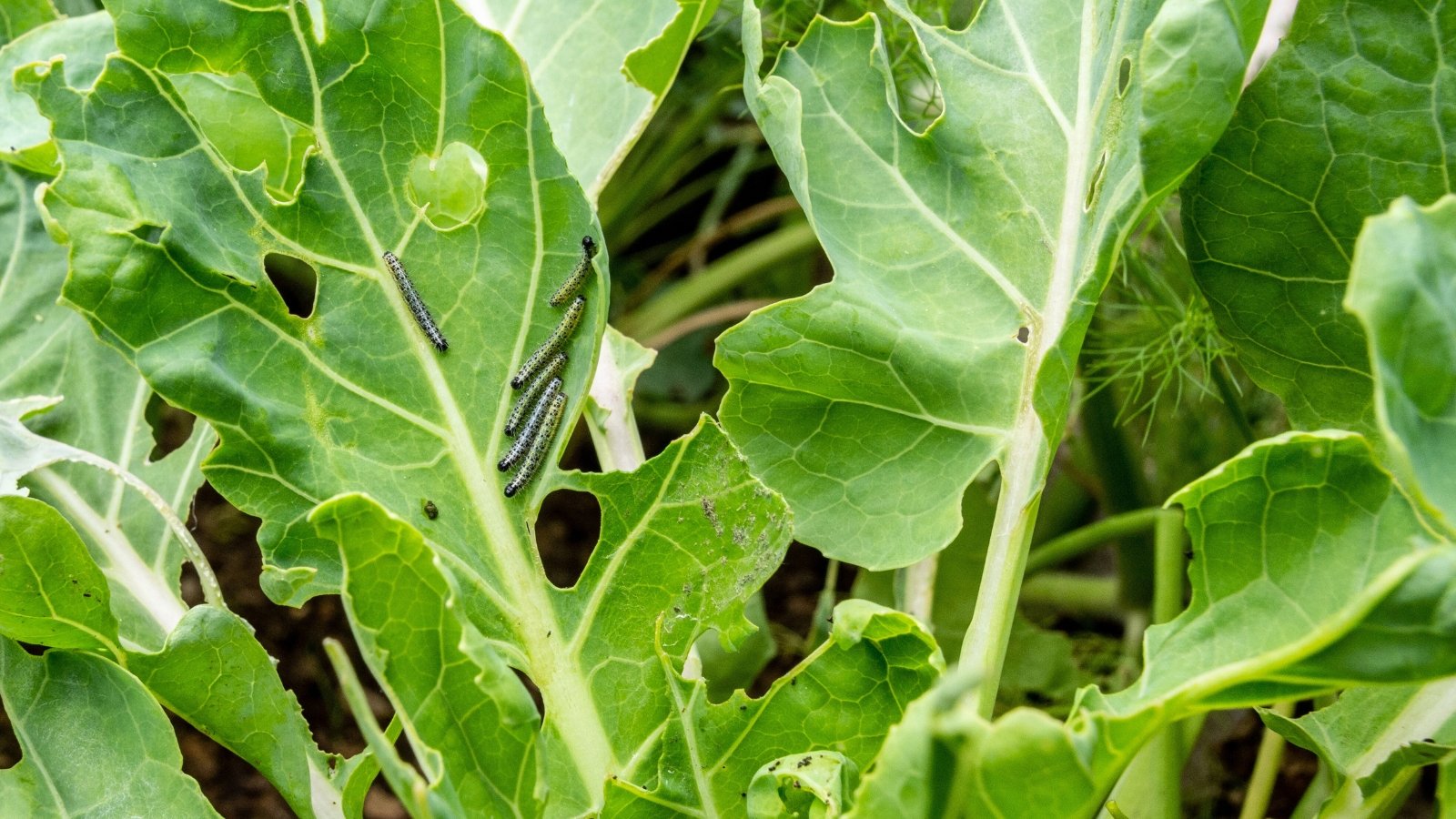

Cabbage worms are frequent fall pests that assault a variety of brassica-family greens. A number of of their favorite crops embrace cabbage, turnips, broccoli, cauliflower, kale, collards, and bok choy. They chew on the leaves, leading to ragged holes and presumably defoliated crops.
The caterpillars vary in look counting on the species. Imported cabbage worms are gentle inexperienced. Cross-striped cabbage worms have gentle blue and black striped backs and massive yellow and black stripes all through the sides of their our our bodies.
Every of the species mature into moths that lay their eggs on the undersides of leaves. The imported cabbageworm lays single, gentle yellow rectangular eggs, whereas the cross-striped worm lays clusters of flat, yellow eggs.
Administration Selections
One of many easiest methods to manage cabbage worms is decided by the number of worms in your crops. In case you occur to identify a handful of worms and eggs, it’s possible you’ll take away them by hand. Nonetheless, keep in mind the adults will proceed to place eggs in your crops.
In case you may have an enormous infestation and loads of tiny caterpillars, it’s possible you’ll spray the crops with Bt. This micro organism enters into the digestive tracts of members of the Lepidoptera family and stops them from feeding. It’s not going to harm totally different bugs, nevertheless it’s best to on a regular basis observe software program instructions when using it.
Cabbage Loopers
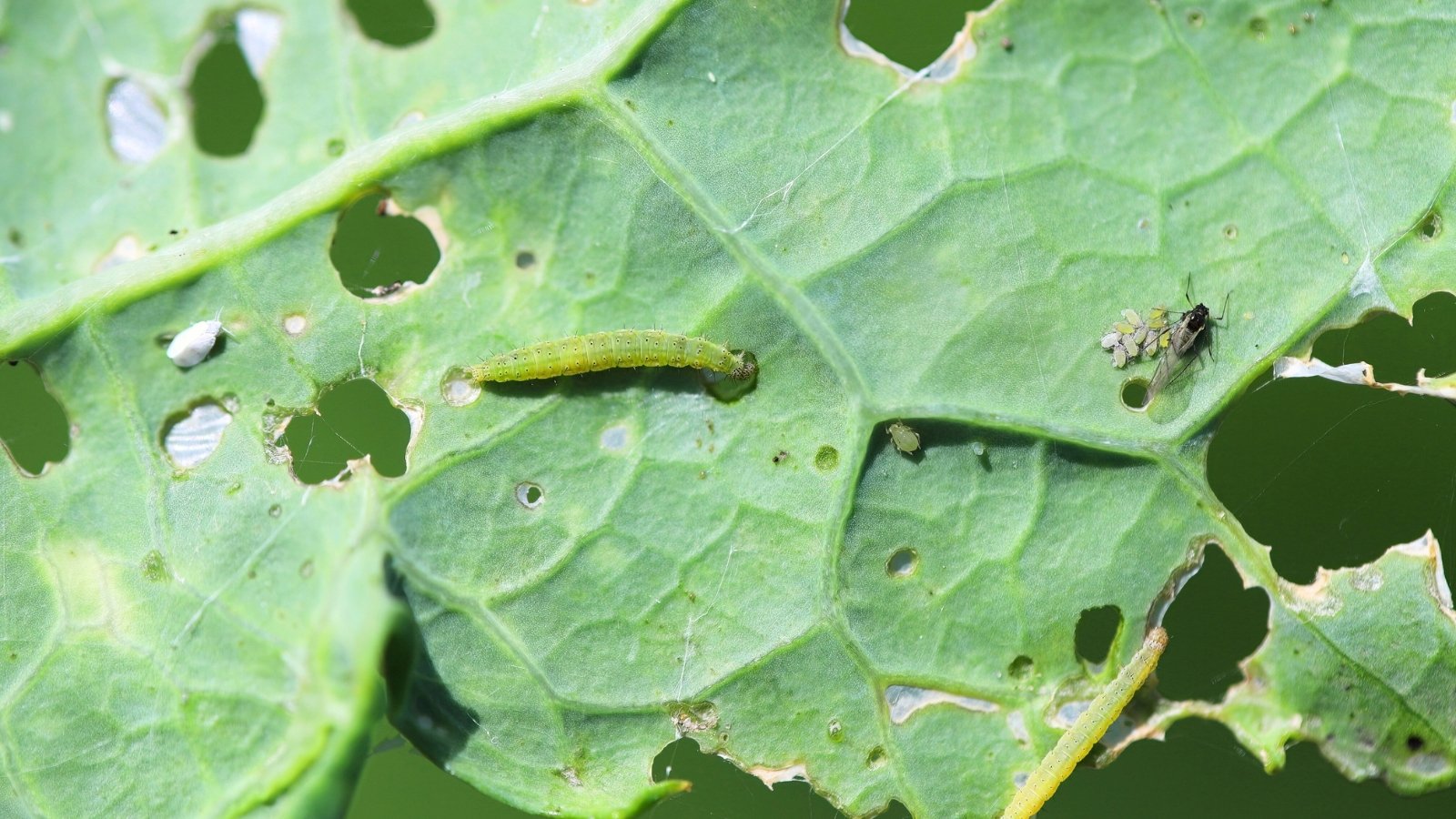

Although some gardeners sometimes confuse them with cabbage worms, cabbage loopers are a very completely totally different pest. They’re further slender than totally different comparable pests and switch like an inchworm. They’re moreover on a regular basis gentle inexperienced, with faint white stripes down their sides.
These pests feed on fairly a couple of fall brassica-family greens, along with cabbage, kale, broccoli, cauliflower, and collards. Although they’re present all by lots of the rising season, you’ll sometimes uncover a essential improve in train throughout the fall.
When the larvae are youthful, they feed on the undersides of leaves. On account of this truth, likelihood is you will not uncover they’re there after they first appear. As they become old, they chew by the use of your whole leaf, inflicting irregular holes. If left untreated, they are going to defoliate full leaves.
Along with in search of the larvae, it’s possible you’ll as effectively preserve a be careful for the eggs and adults. The adults are small brown moths typically known as owlet moths. These moths lay single gentle yellow eggs on brassica leaves.
Administration Selections
One approach to administration cabbage loopers is to take away the eggs and larvae by hand. You presumably can each crush them in your fingers or place them in a bucket full of soapy water.
One other alternative is to spray the contaminated crops with Bt. It’s a naturally occurring soil micro organism that harms the digestive tracts of moth and butterfly larvae. When the cabbage loopers ingest the micro organism, they stop feeding and die. Since Bt washes off throughout the rain, you will probably should spray your crops as quickly as every week.
You can also exclude cabbage loopers out of your plant with row cowl. Merely make sure that there aren’t any eggs or larvae in your crops sooner than you cowl them!
Flea Beetles
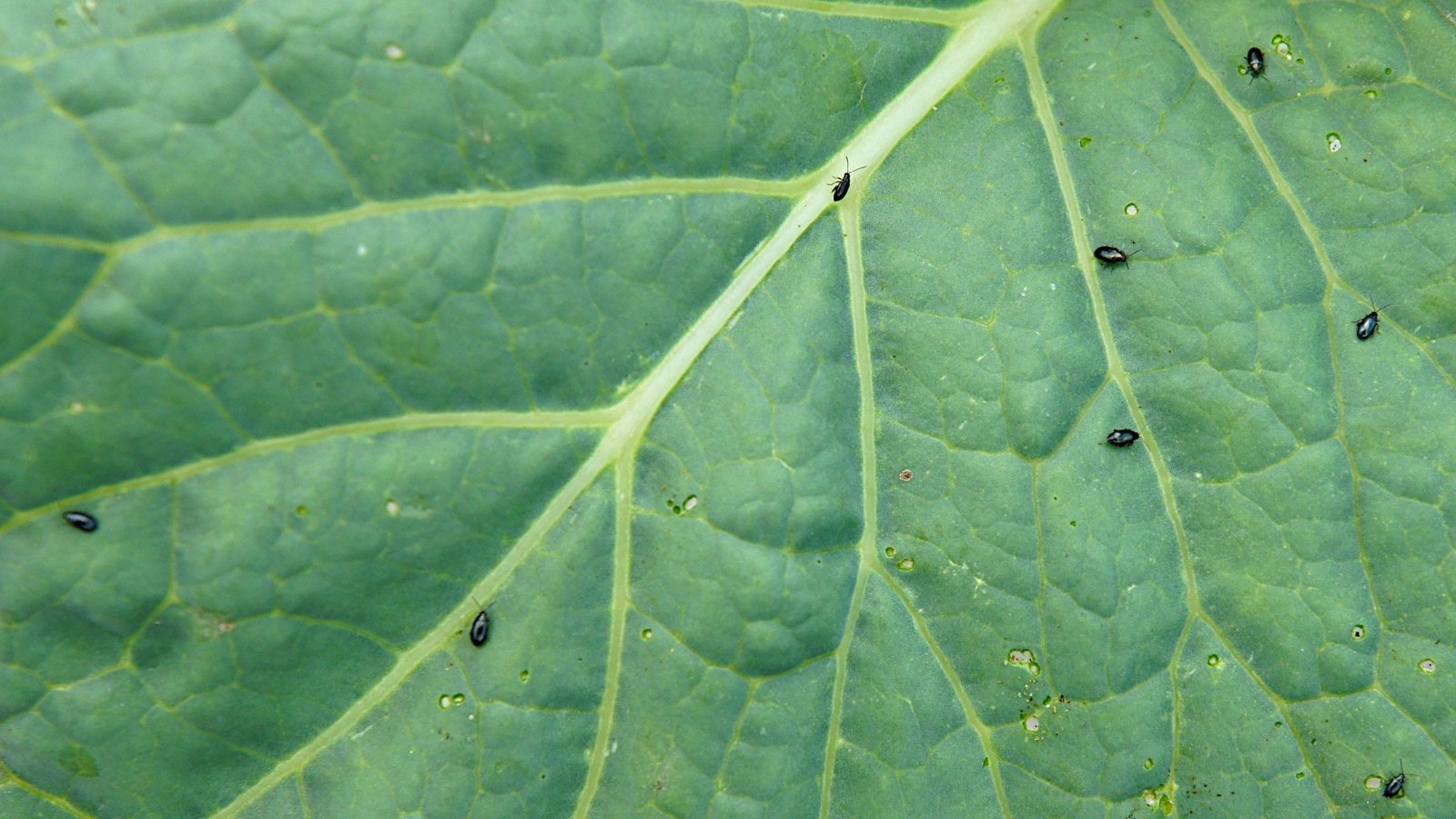

Although they’re small, flea beetles can shortly decimate leafy brassicas like arugula, radish greens, kale, collards, and bok choy. Some species moreover eat crops like spinach, peppers, and eggplant. These pests are generally a much bigger downside in warmth local weather nevertheless keep throughout the yard into the autumn.
There are a selection of flea beetle species, nevertheless all of them look comparable. They’ve rectangular our our bodies which could be black, bronze, or gray and slender legs they use to leap temporary distances. Most species are decrease than 1 / 4 of an inch prolonged. No matter their small dimension, they are going to eat masses in a day, leaving small ‘shothole’ hurt throughout the leaves.
Flea beetles aren’t extra more likely to kill crops, nevertheless they lead to ugly leaves. Over time, crops can develop to be stunted and weak due to the hurt.
Administration Selections
Among the many finest strategies to cease flea beetle hurt is to bodily exclude the tiny bugs out of your crops. You presumably can lay a piece of row cowl or insect netting over your crops and secure the sides to the underside with sandbags or totally different heavy objects. Merely make sure that there aren’t any pests in your crops sooner than you cowl them, in any other case you’ll merely be trapping them in.
You can also spray the pests with pure pesticides. Some environment friendly decisions embrace pyrethrins and spinosad. In case you occur to pick out to utilize chemical controls, make sure that to scrupulously observe product instructions.
Cutworms
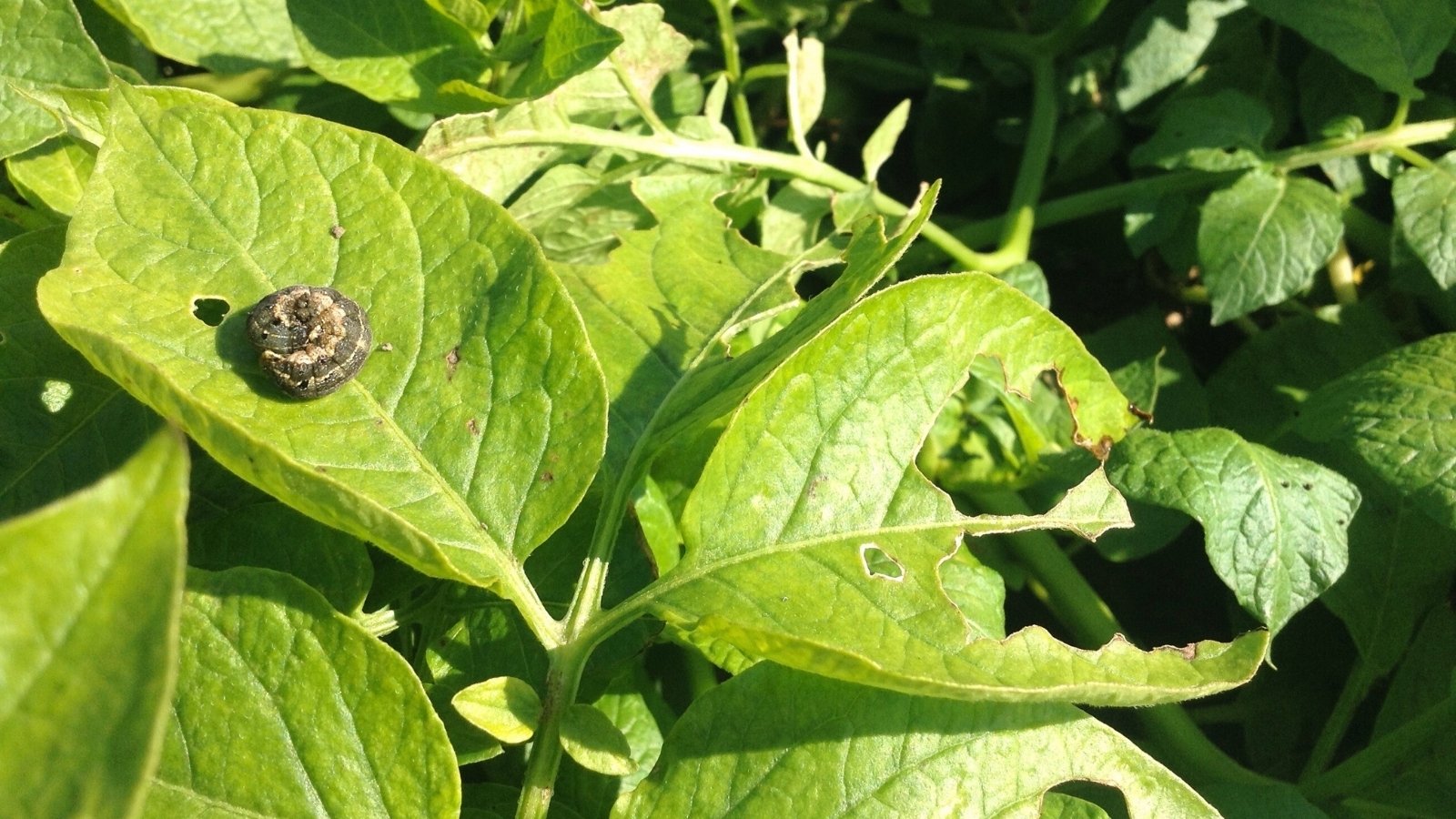

Cutworm is the generic determine for moth larvae that feed on youthful plant stems. The larvae scale back all by the stem, inflicting the seedlings to fall to the underside. Since cutworms eat small stems, seedlings are basically essentially the most susceptible to wreck. The pests feed on a variety of crops, along with cabbage, kale, collards, beans, peppers, and lettuce.
Although the completely totally different species vary in look, they share some similarities. The larvae are plump, hairless, and some variation of brown, black, and gray. They sometimes curl up proper right into a C-shape when touched.
The worms sometimes conceal in particles all through the day and feed at evening time. On account of this truth, it could be powerful to determine them. Nonetheless, digging near the bases of the contaminated crops will sometimes reveal the pests.
Administration Selections
Since cutworms conceal beneath soil particles, steer clear of mulching near the underside of not too way back transplanted seedlings. You presumably can add mulch as quickly because the seedlings are larger. You additionally must preserve your yard weed-free and take away any plant particles that falls on the underside.
Given that cutworms eat by the use of full stems, spraying crops with pesticides isn’t environment friendly. Nonetheless, it’s possible you’ll bodily defend tender seedlings by placing a cardboard or aluminum foil collar throughout the bottom of the stem. Place an inch or two of the material beneath the soil and depart one different two inches above the underside.
[ad_2]
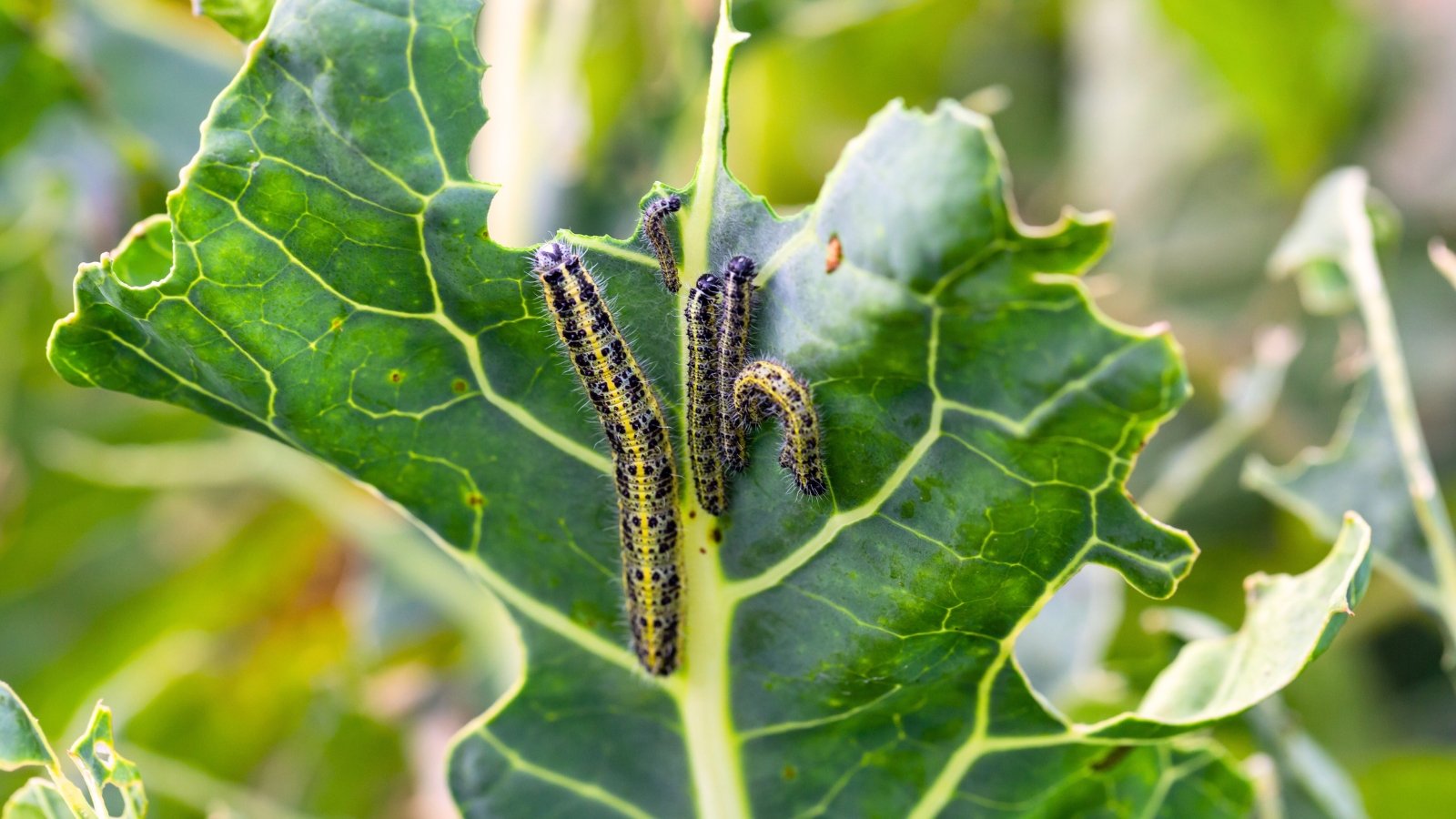
I found this guide very informative regarding fall vegetable gardening. The emphasis on natural predators is reassuring, as I prefer using eco-friendly methods rather than chemicals in my garden whenever possible.
This article highlights important pest issues that can arise in fall gardens. I found the section on aphids quite enlightening, as I’ve struggled with them before and will try the suggested management techniques this season.
The information presented is very thorough and educational. Knowing which pests to look for and how to deal with them effectively can save a lot of frustration during the gardening process, especially as seasons change.
The article provides a comprehensive overview of fall pests in gardens. I appreciate the detailed explanations of each pest’s behavior and management strategies. It’s helpful for novice gardeners like myself who want to maintain healthy crops.
It’s interesting to see how different pests affect various plants during the fall season. The tips on natural control methods are particularly useful and align with sustainable gardening practices that many are trying to adopt today.